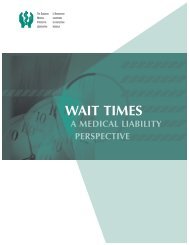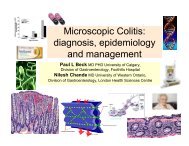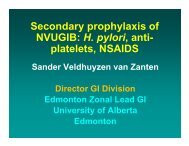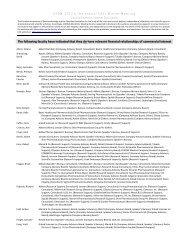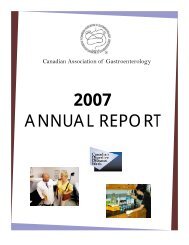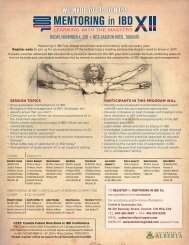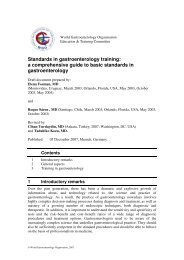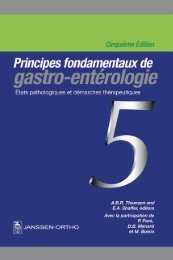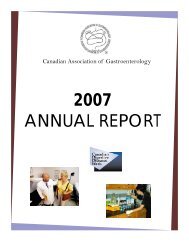Manifestations of Gastrointestinal Disease in the Child
Manifestations of Gastrointestinal Disease in the Child
Manifestations of Gastrointestinal Disease in the Child
Create successful ePaper yourself
Turn your PDF publications into a flip-book with our unique Google optimized e-Paper software.
716 FIRST PRINCIPLES OF GASTROENTEROLOGY<br />
5.4 Management – Oral Rehydration Therapy<br />
5.4.1 ORAL REHYDRATION<br />
In children with acute diarrhea associated with mild to moderate dehydration,<br />
<strong>the</strong> adm<strong>in</strong>istration <strong>of</strong> a balanced oral rehydration solution (ORS) should be<br />
immediately <strong>in</strong>stituted as described <strong>in</strong> Table 10. Parents should be <strong>in</strong>structed<br />
<strong>in</strong> <strong>the</strong> proper adm<strong>in</strong>istration <strong>of</strong> oral rehydration <strong>the</strong>rapy as part <strong>of</strong> preventive<br />
health care. An oral rehydration solution with a carbohydrate-to-sodium ratio<br />
<strong>of</strong> less than 2:1 and an osmolality that is similar to or slightly less than plasma<br />
is recommended. In North America, most oral rehydration solutions have a<br />
sodium content <strong>of</strong> 45–75 mmol/L because stool sodium losses (approximately<br />
35–45 mmol/L) <strong>in</strong> viral enteritis are much less than those <strong>in</strong> secretory diarrheas<br />
such as cholera (90–140 mmol/L). For children with cont<strong>in</strong>ued high<br />
purg<strong>in</strong>g rates (> 10 mL/kg/hr), solutions with a higher sodium content may be<br />
required. When solutions with a sodium content <strong>of</strong> > 60 mmol/L are used for<br />
ma<strong>in</strong>tenance, low-sodium fluids such as breast milk, <strong>in</strong>fant formula, diluted<br />
juice or water must be provided simultaneously to prevent <strong>the</strong> development <strong>of</strong><br />
hypernatremia. In North America, <strong>in</strong>travenous electrolyte solutions are used<br />
to manage children with severe dehydration because <strong>of</strong> <strong>the</strong>ir wide availability<br />
and high degree <strong>of</strong> success. In <strong>the</strong> develop<strong>in</strong>g world, children suffer<strong>in</strong>g from<br />
severe dehydration can usually be successfully rehydrated with oral solutions.<br />
More than 90% <strong>of</strong> vomit<strong>in</strong>g <strong>in</strong>fants can be successfully rehydrated and<br />
ma<strong>in</strong>ta<strong>in</strong>ed with oral hydration provid<strong>in</strong>g 5–10 mL every 2 to 3 m<strong>in</strong>utes<br />
and gradually <strong>in</strong>creas<strong>in</strong>g <strong>the</strong> amount adm<strong>in</strong>istered.<br />
About 5–10% <strong>of</strong> children fail <strong>in</strong>itial oral rehydration <strong>the</strong>rapy as a result <strong>of</strong><br />
ei<strong>the</strong>r persistent vomit<strong>in</strong>g or a persistently high stool<strong>in</strong>g rate <strong>of</strong> > 10 mL/kg/hr.<br />
Parents should be <strong>in</strong>structed to seek fur<strong>the</strong>r care if <strong>the</strong> child develops (1) irritability<br />
or lethargy that <strong>in</strong>hibits dr<strong>in</strong>k<strong>in</strong>g, (2) <strong>in</strong>tractable vomit<strong>in</strong>g, (3) worsen<strong>in</strong>g<br />
fluid deficits associated with persistent diarrhea, (4) bloody diarrhea, or<br />
(5) decreased ur<strong>in</strong>ary output. These children require re-evaluation and <strong>in</strong>travenous<br />
rehydration similar to that provided for <strong>the</strong> severely dehydrated child.<br />
Their hydration status should be monitored, and when rehydration is complete,<br />
ma<strong>in</strong>tenance <strong>the</strong>rapy to replace ongo<strong>in</strong>g losses can be commenced. If dehydration<br />
persists, <strong>the</strong> fluid deficit should be recalculated and rehydration <strong>the</strong>rapy<br />
cont<strong>in</strong>ued for an additional 2 to 4 hours with ongo<strong>in</strong>g assessment <strong>of</strong> fluid losses.<br />
There are only a few contra<strong>in</strong>dications to <strong>the</strong> use <strong>of</strong> oral rehydration<br />
<strong>the</strong>rapy for <strong>the</strong> <strong>in</strong>itial management <strong>of</strong> acute diarrheal disease. These <strong>in</strong>clude<br />
(1) severe (> 10%) dehydration associated with hemodynamic <strong>in</strong>stability,<br />
(2) refusal to dr<strong>in</strong>k due to extreme irritability, lethargy, stupor or coma, and<br />
(3) <strong>in</strong>test<strong>in</strong>al ileus. These children should be managed <strong>in</strong>itially with <strong>in</strong>travenous<br />
fluids and switched to oral rehydration <strong>the</strong>rapy when <strong>the</strong>y can safely




